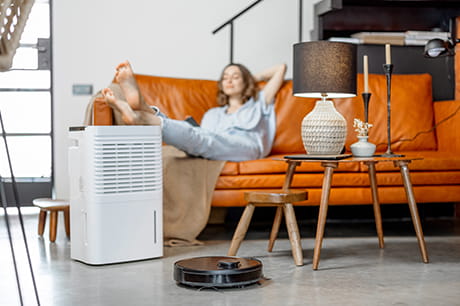What does an air quality alert mean for your health?
Headaches, coughing and eye irritation are just some of the symptoms of bad air quality.
Stepping outside to get a breath of fresh air is great. Stepping outside to get a breath of smog and haze? Not so much.
Breathing in pollutants like wildfire smoke or factory emissions not only puts a damper on your outdoor activities, but it’s also bad for your health.
“While people with lung conditions like asthma are at a higher risk for complications, the health effects of air pollution can impact everyone,” says Jonathan Spahr, MD, a pediatric pulmonologist at Geisinger.
Know what air quality alerts mean for you and the steps you can take to breathe easier.
How is air pollution measured?
The Air Quality Index (AQI) is a scale used by the Environmental Protection Agency (EPA) to track five major pollutants:
- Ground-level ozone
- Particle pollution (also known as particulate matter)
- Carbon monoxide
- Sulfur dioxide
- Nitrogen dioxide
Based on the highest level of any of these pollutants, the EPA labels air quality using six color-coded categories:
- Green/good (0–50): Air quality is satisfactory, and air pollution poses little or no risk.
- Yellow/moderate (51–100): Air quality is acceptable. However, there may be a risk for some people, particularly those who are unusually sensitive to air pollution.
- Orange/unhealthy for sensitive groups (101–150): Members of sensitive groups may have health effects. The general public is less likely to be affected.
- Red/unhealthy (151–200): Some people may have health effects; members of sensitive groups may have more serious health effects.
- Purple/very unhealthy (201–300): Health alert: The risk of health effects is increased for everyone.
- Maroon/hazardous (301+): Health warning of emergency conditions: Everyone is more likely to be affected.
“Air quality is a lot like the weather — it can change rapidly within a week or even throughout the day,” says Dr. Spahr. “Understanding what each of the AQI categories means can help you better prepare and protect yourself.”
What is an air quality alert?
An air quality alert is a warning issued by the government when air pollution levels reach unhealthy or hazardous levels.
“An orange or red alert means sensitive groups like children, older adults and people with conditions like asthma, allergies or chronic obstructive pulmonary disease (COPD) will be most affected,” explains Dr. Spahr. “But when a purple or maroon air quality alert is issued, that’s something everyone should pay attention to.”
To stay up to date on air quality in your area, enter your zip code into the EPA’s online AirNow tool. It can show the latest data near you and help you plan ahead with air quality forecasts.
Health effects of air pollution
The quality of the air around you plays a big role in your overall health.
“Every time you breathe, you’re bringing the outside world into your lungs and into your body,” says Dr. Spahr. “But when the air’s heavy with pollutants or irritants, they can get into the lungs and cause significant inflammation.”
Common short-term symptoms of bad air quality include:
- Difficulty breathing
- Coughing or wheezing
- Chest tightness or pain
- Racing heartbeat
- Headaches
- Sore throat
- Fatigue
- Eye irritation
- Dizziness
“In the long term, exposure to air pollution can affect more than just your lungs,” says Dr. Spahr. “Studies have linked poor air quality to an increased risk of strokes, heart attacks and even some cancers.”
Air pollution can also worsen conditions like:
- Asthma
- COPD
- Respiratory infections like bronchitis, colds or pneumonia
- Emphysema
- Allergies
“If you have lung disease or breathing problems, even low levels of air pollution could cause a flare-up or exacerbate your symptoms," says Dr. Spahr.
What to do when air quality is unhealthy
If an air quality alert is issued in your area, you can take steps to protect your health. Dr. Spahr recommends the following:
- Most importantly, stay indoors and avoid strenuous outdoor activities like hiking or playing sports.
- If you do have to go out for a long period of time, consider wearing an N-95 mask to filter out pollutants.
- Keep windows and doors closed.
- Run air conditioners, but make sure the filter is clean and up to date.
- Use the air recirculation button in your car.
- Use a high-efficiency particulate air (HEPA) air purifier that doesn’t generate ozone.
- Don’t burn candles, incense or firewood inside.
- Skip vacuuming unless your vacuum has a HEPA filter.
“Whether or not you have a breathing condition, staying informed about air quality in your area and taking a few simple precautions can go a long way toward better health,” says Dr. Spahr.
Next steps:
Have asthma? Here’s how to manage flares
Need care today? Try virtual urgent care
Learn more about lung and respiratory care at Geisinger

